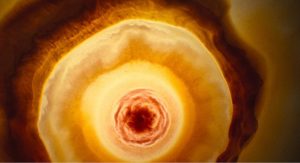STUDIO: Criterion | DIRECTOR: Terrence Malick | CAST: Jessica Chastain, Brad Pitt, Sean Penn, Hunter McCracken, Laramie Eppler, Tye Sheridan, Fiona Shaw
RELEASE DATE: 9/11/18 | PRICE: DVD $25.97, Blu-ray $39.96
BONUSES: 2011 featurette “Exploring ‘The Tree of Life’ ”; new interviews with Jessica Chastain, senior visual-effects supervisor Dan Glass, critic Alex Ross; video essays by critic Benjamin B and critic Matt Zoller Seitz and editor Serena Bramble
SPECS: PG-13 | 139 min./189 min. | Drama | 1.85:1 widescreen | 5.1 surround| English and Spanish subtitles
People either love or hate The Tree of Life. There’s no in-between with the film because it is such an extreme work — an abstract, non-linear telling of a rather simple story that stops early on to flash back to the formation of the universe and then returns to its storyline, which is told in a fragmented fashion that incorporates memories, dreams, and fantasies.
It’s therefore unlike anything made in the Hollywood mainstream since 2001: A Space Odyssey and the “maverick”-era when American directors acknowledged, referenced, and sometime just stole from American and foreign avant-garde and “underground” films. Its creator, Terrence Malick (Days of Heaven, Badlands) was a product of that era, but it took him until 2011 to realize his dream project — a film that he had scripted much earlier, with photos and other items taped onto the pages of his screenplay.
The plot, once it is assembled by the viewer, concerns a troubled architect (Sean Penn, Fair Game) who is haunted by memories of his kid brother who died in Vietnam. We view his Texas childhood in the Fifties and witness he and his two brothers learning about the gentler side of life from their sensitive mother (Jessica Chastain, Jolene) and the tougher, dog-eat-dog realities of existence from their no-nonsense father (Brad Pitt, Seven).
 This package contains both the original 139-minute theatrical version of the film and a “director’s cut” running 189 minutes that was funded, in a very rare move, by Criterion itself. The most fascinating aspect of this is that the longer-by-a-third version doesn’t contain any more of the abstract formation of the universe sequence. That segment of the film still clocks in under 20 minutes, most likely due to the fact that Malick spun off that idea into a trippy 2016 documentary titled Voyage of Time (which has been released overseas on Blu-ray but not in the U.S.).
This package contains both the original 139-minute theatrical version of the film and a “director’s cut” running 189 minutes that was funded, in a very rare move, by Criterion itself. The most fascinating aspect of this is that the longer-by-a-third version doesn’t contain any more of the abstract formation of the universe sequence. That segment of the film still clocks in under 20 minutes, most likely due to the fact that Malick spun off that idea into a trippy 2016 documentary titled Voyage of Time (which has been released overseas on Blu-ray but not in the U.S.).
Thus, given the ability to create a longer version of the film by Criterion president Peter Becker, Malick edited in more trippy imagery and visually arresting moments of wonder, but they also include many more moments of discord — among them, arguments with other family members, more experiences of Penn’s adult character, and an array of sequences in which the young boys of the family and their friends destroy things or harm animals (all offscreen). Thus, the director’s cut is a far harsher film by a long shot than the theatrical version.
Since the beginning of his career, Malick has refused to do interviews, so his absence in the supplements here is not surprising. Although the events of the film can well be deemed semi-autobiographical (Malick grew up in the South and had a brother who died young), that aspect is not addressed here. Instead, we learn about his directorial methods and the way that the cast and crew collaborated on the film, adding improvised moments and images to what was seemingly a tightly planned but also “wide open” film shoot.
A featurette made by Laurent Bouzereau for the 2011 DVD release of the film covers a lot of ground. It’s the only time we hear from Pitt in this package. (He also served as a producer and was very likely the central reason the film got made.) We also hear from a number of other participants; testifying to Malick’s genius are celebrity fans Christopher Nolan and David Fincher.
Visual essays by Benjamin B and Matt Zoller Seitz and editor Serena Bramble explore the film’s visuals in an academic fashion. B calls the images “cubist” because Malick encouraged the camera people to ignore continuity on actions shot from multiple angles (but that isn’t apparent to the average viewer, who would need to watch the film in slow motion to catch the mismatches). A more apt metaphor in his visual essay occurs when he describes the film’s visual approach as being like jazz, because Malick trusted his camera people enough to catch certain shots however they could, and improvise some bits of business with the actors.
 In an onscreen interview created for this package, critic Alex Ross offers a valuable and informative exploration of the classical and neo-classical music used on the film’s soundtrack. He notes the elegiac tone of the works chosen by Malick for the picture and provides a discussion of both the original history of the pieces and how they evoke certain emotions in the context of the film.
In an onscreen interview created for this package, critic Alex Ross offers a valuable and informative exploration of the classical and neo-classical music used on the film’s soundtrack. He notes the elegiac tone of the works chosen by Malick for the picture and provides a discussion of both the original history of the pieces and how they evoke certain emotions in the context of the film.
Don Glass, the senior visual-effects supervisor, discusses the “origin of the universe” scene at length in another new onscreen interview. He explains how four different companies designed different elements in the segment, with one company each working on the microbial and astrophysical aspects. This featurette reminds one of just how much incredible work went into a sequence that runs less than 20 minutes in all iterations of the movie.
The most enthusiastic take on the film isn’t supplied by a critic or crew member — it comes from the film’s star, Jessica Chastain, in a new interview. She describes acting in Tree of Life as like “being in a visual poem” and like being part of a dance troupe. She also discusses her character’s most unusual moment — when she is seen dancing in the air in the front yard of the family house.
We see short snippets of Chastain’s audition tapes and the tapes made for the child actors. She also reflects on her voiceover narration, noting that she was called back by Malick several times after the shoot was finished, her estimate being that she recorded 20 hours of v.o.
Her enthusiasm for the picture is infectious, especially when she describes a technique that Malick taught her that she has used on films since. It involves doing the scene as written and then attempting it without the dialogue, letting the gestures convey the character’s attitude.
Chastain’s star has certainly risen since Tree of Life, but she has very strong feelings about Malick’s non-linear avant-garde allegory, calling it “the film and the part that has touched me the most.”
|
Buy or Rent The Tree of Life (2011)
|
|---|
Leave a Reply